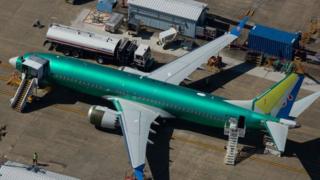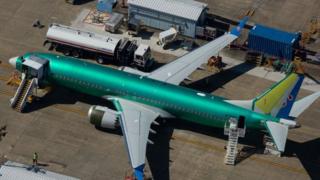Boeing 737 Max: Worker said plane ‘designed by clowns’
The release of a batch of internal messages raises more questions about the safety of Boeing’s 737 Max. …

 Image copyright Getty Images
Image copyright Getty Images The release of a batch of internal messages has raised more questions about the safety of Boeing’s 737 Max.
In one of the communications, an employee said the plane was “designed by clowns”.
The planemaker described the communications as “completely unacceptable”.
The 737 Max was grounded in March 2019 after two fatal crashes in Indonesia and Ethiopia, which killed almost 350 people in total.
Boeing said it had released the hundreds of redacted messages as part of its commitment to transparency.
The Federal Aviation Administration (FAA) and US Congress were given unredacted versions of the communications last month.
“These communications do not reflect the company we are and need to be, and they are completely unacceptable,” Boeing said.
Simulator pushback
One unnamed employee wrote in an exchange of instant messages in April 2017: “This airplane is designed by clowns who in turn are supervised by monkeys.”
The documents, which have been published by the Washington Post, appear to show that Boeing rejected pilots being trained on simulators, which would have led to higher costs for its customers, making its aircraft less attractive.
“I want to stress the importance of holding firm that there will not be any type of simulator training required to transition from NG to Max,” Boeing’s 737 chief technical pilot at the time, Mark Forkner, said in a March 2017 email.
“Boeing will not allow that to happen. We’ll go face to face with any regulator who tries to make that a requirement.”
On Tuesday this week, Boeing reversed its position by recommending 737 Max simulator training for all pilots.
These messages refer to Boeing employees telling lies, covering up problems and treating regulators with contempt.
They reinforce the impression – already expressed vividly by whistleblowers and in Congressional hearings – that Boeing was a company that had lost its way, focused on maximising production and keeping costs down, rather than on safety.
Emails from the company’s chief technical pilot show just how determined the company was to keep training requirements to a minimum, for pilots used to the previous generation of 737 Max, and to prevent them from being required to spend extra time in a flight simulator.
They show how ready Boeing was to go toe-to-toe with any regulator that thought otherwise.
Minutes from a meeting even illustrate how careful Boeing was in its communications about MCAS – the flight control system implicated in both crashes.
They appear to have been trying to keep a lid on the fact it was a new system, to minimise demands for extra training.
Will all this actually harm Boeing though? It’s questionable.
The company’s reputation has already been savaged; it may be calculating that it now has little to lose by being transparent about past failures.
But it is easy to see now why the relationship between Boeing and the Federal Aviation Administration has deteriorated so far – and why the recertification of the 737 Max has taken so long.
Another message dating from November 2015 appears to show that the company lobbied against the aviation regulator’s calls for a certain aspect of simulator training.
“We are going to push back very hard on this and will likely need support at the highest levels when it comes time for the final negotiation,” the message said.
The documents also appear to show problems with the simulators being discussed.
In February 2018, a Boeing worker asked a colleague: “Would you put your family on a Max simulator-trained aircraft? I wouldn’t.”
“No,” came the reply.
‘Covering up’
In other emails and instant messages, employees spoke of their frustration with the company’s culture, complaining about the drive to find the cheapest suppliers and “impossible schedules”.
“I don’t know how to fix these things… it’s systemic. It’s culture. It’s the fact we have a senior leadership team that understand very little about the business and yet are driving us to certain objectives,” said an employee in an email dated June 2018.
And in a May 2018 message, an unnamed Boeing employee said: “I still haven’t been forgiven by God for the covering up I did last year.”
Without citing what was covered up, the employee added: “Can’t do it one more time, the pearly gates will be closed.”
Timeline: Boeing crashes
- 29 October 2018: A 737 Max 8 operated by Lion Air crashes after leaving Indonesia, killing all 189 people on board
- 31 January 2019: Boeing reports an order of 5,011 Max planes from 79 customers
- 10 March 2019: A 737 Max 8 operated by Ethiopian Airlines crashes, killing all 157 people on board
- 14 March 2019: Boeing grounds entire 737 Max aircraft fleet
US House transportation committee chairman Peter DeFazio – who has been investigating the 737 Max – said the communications “show a co-ordinated effort dating back to the earliest days of the 737 Max programme to conceal critical information from regulators and the public”.
Senator Roger Wicker, who chairs the commerce committee leading the senate’s probe into Boeing, said the documents “raise questions about the efficacy of FAA’s oversight of the certification process”.
The FAA said: “Any potential safety deficiencies identified in the documents have been addressed.”
However, the regulator added: “The tone and content of some of the language contained in the documents is disappointing.”
Boeing added that some of the messages “raise questions” about the company’s interactions with the FAA in discussions about the simulator.
But it added: “We remain confident in the regulatory process for qualifying these simulators.”
Boeing is redesigning the automated control system thought to have been the primary cause of the crashes.
The company has temporarily stopped making the 737 Max.
Last month, Boeing fired chief executive Dennis Muilenburg.



